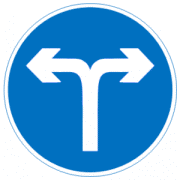I heard someone recently criticising their pupils’ education because they sometimes got their lefts and rights mixed up.
I encounter left-right confusion frequently when I’m te aching, but never – for even a moment – have I attributed it to the standard of someone’s education. In fact, it is a known – but not completely understood – scientific phenomenon (it’s also one of the symptoms of dyslexia, though not necessarily one experienced by all dyslexics).
aching, but never – for even a moment – have I attributed it to the standard of someone’s education. In fact, it is a known – but not completely understood – scientific phenomenon (it’s also one of the symptoms of dyslexia, though not necessarily one experienced by all dyslexics).
Kids are taught their lefts and rights from the earliest age, and when they turn 17 – unless they’re dyslexic and this is one of their symptoms – they know exactly where left and right are.
Indeed, when I was a child I had no problem at all with telling left from right, or in being able to identify one or the other instantly, and I don’t have a problem now. But for about 4 or 5 years in my late teens and early 20s I went through a phase where I often had to think hard about which was which when challenged to do so for some reason. As a typical teenager, it really had me worried because I knew there was an issue where there wasn’t one before. But it disappeared as suddenly as I’d noticed it appear. In later years I have always attributed it to the changes that occur as people mature physically. I am not dyslexic in any way, either.
The problem, as distinct from dyslexia, apparently affects around 20-25% of the population. Even if you leave out my own theory of it affecting young people more than older ones, that still means a quarter of your pupils are likely to encounter difficulties.
It can be a particular problem on driving lessons and driving tests. Why? Well, if someone is just driving to Tesco or to see their gran, they usually know where they’re going and don’t need to think about right or left – it’s just “this way” or “that way”. But on lessons and tests directional instructions are given, and the driver then has to translate “left” or “right” into real actions. That’s when the left-right confusion kicks in.
The one thing to remember is that no matter how badly someone is affected by this left-right confusion, it is not terminal as far as learning to drive is concerned.
There are all kinds of things the instructor can do or advise to try to help them. Here are just a few:
- When you hold your left thumb and forefinger out straight, they make an ‘L’ shape
- Draw a big dot on the left hand remember that that’s LEFT
- Actually write ‘L’ and ‘R’ on your hands
- Put ‘L’ and ‘R’ stickers on the dashboard (or the mirror)
- The ADI can use gestures as well as the words ‘left’ and ‘right’ when giving directions
- The examiner can do this, too, so ask them to use a hand gesture if you think it will help on your test
- Stay calm and take your time when making decisions
Some of those are also advised by the British Dyslexia Association. The mirror one came from a reader.
But one thing you should never do is assume that the person in question is somehow lacking or deficient – educationally or any other way.
Left/right confusion in older people
Someone found the blog on that search term. I am not aware of a specific problem developing as people get older (that is, as they pass from their 20s to their 30s or 40s). However, confusion and slower mental response can occur when people become much older (60s and 70s onwards), and I guess left/right confusion may be one of the possible symptoms of that.
Bear in mind that some 30-somethings can be mentally older than some octogenarians, and there are no sharp divisions. Everyone is different.
If it is becoming an issue that worries you, see your GP. That’s what they’re there for. It’s unlikely, but there may be something else wrong that can be treated.